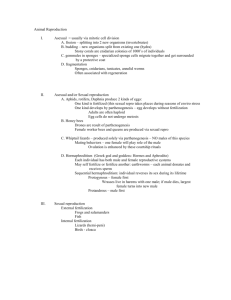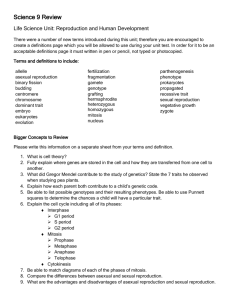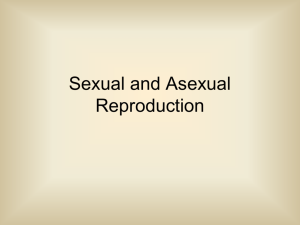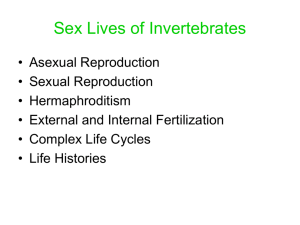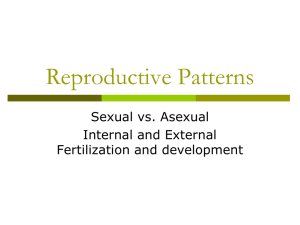Sex Lives of Invertebrates
advertisement
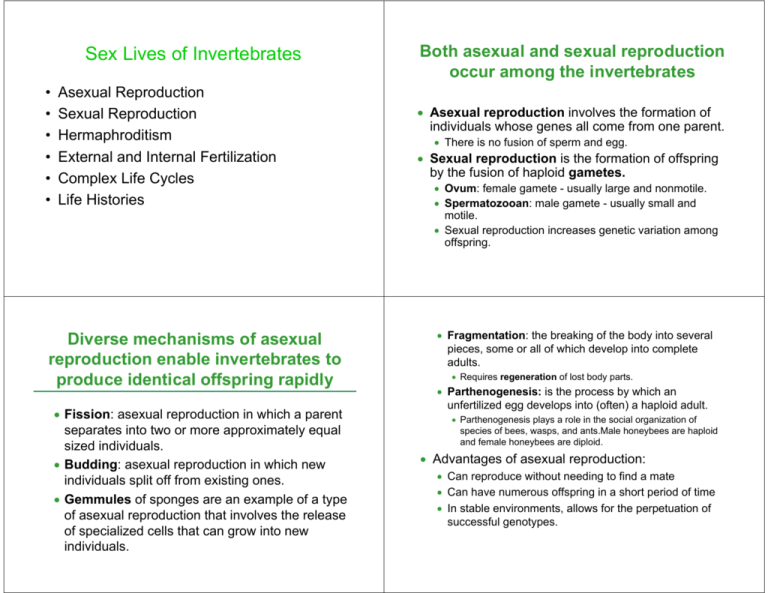
Sex Lives of Invertebrates • • • • • • Asexual Reproduction Sexual Reproduction Hermaphroditism External and Internal Fertilization Complex Life Cycles Life Histories Diverse mechanisms of asexual reproduction enable invertebrates to produce identical offspring rapidly • Fission: asexual reproduction in which a parent separates into two or more approximately equal sized individuals. • Budding: asexual reproduction in which new individuals split off from existing ones. • Gemmules of sponges are an example of a type of asexual reproduction that involves the release of specialized cells that can grow into new individuals. Both asexual and sexual reproduction occur among the invertebrates • Asexual reproduction involves the formation of individuals whose genes all come from one parent. • There is no fusion of sperm and egg. • Sexual reproduction is the formation of offspring by the fusion of haploid gametes. • Ovum: female gamete - usually large and nonmotile. • Spermatozooan: male gamete - usually small and motile. • Sexual reproduction increases genetic variation among offspring. • Fragmentation: the breaking of the body into several pieces, some or all of which develop into complete adults. • Requires regeneration of lost body parts. • Parthenogenesis: is the process by which an unfertilized egg develops into (often) a haploid adult. • Parthenogenesis plays a role in the social organization of species of bees, wasps, and ants.Male honeybees are haploid and female honeybees are diploid. • Advantages of asexual reproduction: • Can reproduce without needing to find a mate • Can have numerous offspring in a short period of time • In stable environments, allows for the perpetuation of successful genotypes. Diverse mechanisms of sexual reproduction • Separate sexes • Simultaneous hemaphroditism • Sequential hermaphroditism • Sexual reproduction in sessile or burrowing animals or parasites who may have difficulty encountering a member of the opposite sex. – Hermaphroditism: one individual is functional as both a male and a female. • Some self-fertilize. • Most mate with another member of the same species. • Each individual receives and donates sperm. • Results in twice as many offspring as would occur if only one set of eggs were fertilized. • Sexual reproduction in echinoderms usually involves the release of gametes by separate males and females into the seawater. – The radial adults develop by metamorphosis from bilateral larvae. • Sequential hermaphroditism: an individual reverses its sex during its lifetime. • Protogynous: female first sequential hermaphrodite. • Protandrous: male first sequential hermaphrodite (slipper shells (Mollucsa: Gastropoda). • Most sponges are hermaphrodites, with each individual producing both sperm and eggs. – Gametes arise from choanocytes or amoebocytes. – The eggs are retained, but sperm are carried out the osculum by the water current. – Sperm are drawn into neighboring individuals and fertilize eggs in the mesohyl. – The zygotes develop into flagellated, swimming larvae that disperse from the parent. – When a larva finds a suitable substratum, it develops into a sessile adult. • Planarians can reproduce asexually through budding and regeneration. – The parent constricts in the middle, and each half regenerates the missing end. • Planarians can also reproduce sexually. – These hermaphrodites cross-fertilize. • Sponges are capable of extensive regeneration, the replacement of lost parts. – They use regeneration not only for repair but also to reproduce asexually from fragments broken off a parent sponge. Internal and external fertilization both depend on mechanisms ensuring that mature sperm encounter fertile eggs of the same species • Internal fertilization requires cooperative behavior that leads to copulation. • External fertilization requires a moist habitat that will protect a developing egg from desiccation and heat stress. – Specific mating behaviors assure that sperm and egg will be in the same place at the same time. Species with internal fertilization usually produce fewer zygotes but provide more parental protection than species with external fertilization • Internal fertilization usually results in the production of fewer zygotes than does external fertilization. • However, the survival rate is lower for external fertilization than it is for internal fertilization. – Parental care of offspring may occur regardless of whether fertilization is external or internal. Complex reproductive systems have evolved in many animal phyla • The least complex reproductive systems lack gonads. • Polychaete worms lack gonads. • Eggs and sperm develop from undifferentiated cells lining the coelom. • Some reproductive systems, such as that seen in parasitic flatworms, can be very complex. • Most insects have separate sexes with complex reproductive systems. • In many species the female reproductive system includes a spermatheca, a sac in which sperm may be stored for a year or more. Reproductive cycles and Life Cycles vary extensively among animals • Reproductive cycles and life cycles are controlled by both environmental and hormonal cues. • Animals may be solely asexual or sexual. • Or they may alternate between the two modes depending on environmental conditions. • Daphnia reproduce by parthenogenesis under favorable conditions and sexually during times of environmental stress (Crustacea). Complex Life Cycles and Alternation of Generations • Most invertebrates have complex life cycles – They pass through morphologically distinct life stages such as planktonic larval stages before transforming into an adult that has a different form and might live in a different habitat. • Some invertebrate also have alternating generations that reproduce sexually or asexually. Complex Life Cycles • Most hydrozoans alternate polyp and medusa forms, as in the life cycle of Obelia. – The polyp stage, often a colony of interconnected polyps, is more conspicuous than the medusas. • Hydras, among the few freshwater cnidarians, are unusual members of the class Hydrozoa in that they exist only in the polyp form. – When environmental conditions are favorable, a hydra reproduces asexually by budding, the formation of outgrowths that pinch off from the parent to live independently. – When environmental conditions deteriorate, hydras form resistant zygotes that remain dormant until conditions improve. • Class Trematoda (Platyhelminthes) parasitize a wide range of hosts, and most species have complex life cycles with alternation of sexual and asexual stages. – Many require an intermediate host in which the larvae develop before infecting the final hosts (usually a vertebrate) where the adult worm lives. – The fluke Schistosoma infects 200 million people. • The blood fluke Schistosoma infects 200 million people, leading to body pains, anemia, and dysentery. • Most Monogenea (Trematoda) are external parasites of fishes. • Tapeworms (class Cestoidea – Phylum Platyhelminthes) are also parasitic. • Mature proglottids, loaded with thousands of eggs, are released from the posterior end of the tapeworm and leave with the host’s feces. – The adults live mostly in vertebrates, including humans. • Suckers and hooks on the head or scolex anchor the worm in the digestive tract of the host. • A long series of proglottids, sacs of sex organs lie posterior to the scolex. • Tapeworms absorb food particles from their hosts. – Their life cycles are simple, with a ciliated, free-living larva that starts an infection on a host. – While traditionally aligned with trematodes, some structural and chemical evidence suggests that they are more closely related to tapeworms. – In one type of cycle, tapeworms eggs in contaminated food or water are ingested by intermediary hosts, such as pigs or cattle. – The eggs develop into larvae that encyst in the muscles of their host. – Humans acquire the larvae by eating undercooked meat contaminated with cysts. – The larvae develop into mature adults within the human. • Phylum Rotifera - The word rotifer, “wheelbearer”, refers to the crown of cilia that draws a vortex of water into the mouth. – Food particles drawn in by the cilia are captured by the jaws (trophi) in the pharynx and ground up. • Nematodes usually engage in sexual reproduction. – The sexes are separate in most species and fertilization is internal. – Females may lay 100,000 or more fertilized eggs per day that produces resistant zygotes. • Abundant, free-living nematodes live in moist soil and in decomposing organic matter on the bottom of lakes and oceans. – They play a major role in decomposition and nutrient recycling. • Some rotifers exist only as females that produce more females from unfertilized eggs (haploid), a type of parthenogenesis. • Other species produce two types of eggs that develop by parthenogenesis. – One type forms females and the other forms degenerate males that survive just long enough to fertilize eggs. – The zygote forms a resistant stage that can withstand environmental extremes until conditions improve. – The zygote then begins a new female generation that reproduces by parthenogenesis until conditions become unfavorable again. • Earthworms are cross-fertilizing hermaphrodites. – Two earthworms exchange sperm and then separate. – The received sperm are stored while a special organ, the clitellum, secretes a mucous cocoon. – As the cocoon slides along the body, it picks up eggs and stored sperm and slides off the body into the soil. • Some earthworms can also reproduce asexually by fragmentation followed by regeneration. • Most mollusks have separate sexes, with gonads located in the visceral mass. – However, many snails are outcrossing hermaphrodites. • The life cycle of many marine mollusks includes a ciliated larvae, the trophophore. – This larva is also found in marine annelids (segmented worms) and some other lophotrochozoans. Life histories are very diverse, but they exhibit patterns in their variability • Life histories are a result of natural selection, and often parallel environmental factors. • Some organisms, such as the spiders,exhibit what is known as big-bang reproduction, where large numbers of offspring are produced in each reproduction, after which the individual often dies. • Reproduction in insects is usually sexual, with separate male and female individuals. – Coloration, sound, or odor bring together opposite sexes at the appropriate time. – In most species, sperm cells are deposited directly into the female’s vagina at the time of copulation. • In a few species, females pick up a sperm packet deposited by a male. – The females store sperm in the spermatheca, in some cases holding enough sperm from a single mating to last a lifetime. – After mating, females lay their eggs on a food source appropriate for the next generation. – This is also known as semelparity. • By contrast, some organisms produce only a few eggs during repeated reproductive episodes. – This is also known as iteroparity. • What factors contribute to the evolution of semelparity and iteroparity?
